The parents of Gabrielle, a second grader at an Illinois public school, recently heard from administrators that their daughter, who liked reading her Bible out loud at recess, could no longer do so. “You just can’t be doing that,” school officials told Gabrielle.
When the school called her parents to talk about the prohibition, they pushed back. The school relented, somewhat, and said Gabrielle could still read the Bible outside at recess but couldn’t do so at any recess held inside the school building.
No other child or parent had ever complained about Gabrielle’s Bible reading. She was not causing a disruption to the educational process.
Gabrielle’s parents were still not happy with the school’s actions, and asked lawyers at the American Center for Law and Justice (ACLJ) for help. ACLJ wrote a letter to the school on the parents’ behalf, reminding administrators that students do not shed their constitutional rights at the schoolhouse gate. That includes the freedom of religion.
After receiving the ACLJ’s letter, the school backed down and removed their restrictions on Gabrielle’s Bible reading. According to a blog post on the ACLJ website, “It was a simple case of public school officials’ hypersensitivity to the specter of a threat from the ACLU or some similar spreader of long-debunked propaganda about ‘separation of Church and State.’”
There’s a common misunderstanding about the First Amendment’s protections of religious freedom that has led public schools over the years to create ill-informed policies that actually cause constitutional violations of the Free Exercise Clause in an attempt to avoid violating the Establishment Clause.
Public schools are government entities, and as such are covered by the First Amendment’s prohibition against “establishing” a government religion. Courts, including the U.S. Supreme Court, have not always been clear as to what that means or where the lines ought to be drawn between the amendment’s prohibition on the government’s actions leading to an “establishment” of religion, on the one hand, and its concurrent duty not to infringe the free exercise of religion on the other.
In addition, the free exercise of religion has historically been implicated along with the freedom of speech, as when students such as Gabrielle read their Bibles out loud in the hearing of other students. And what the Supreme Court has ruled, going back to a famous 1960s case on the subject, is that as long as there is no disruption to the educational process, student speech is constitutionally protected.
So, as it turns out, Gabrielle’s Bible reading was protected by the First Amendment’s guarantees of the freedom of religion as well as the freedom of speech.
The mistaken policy of this particular Illinois school is simply one in a long series of similar First Amendment misunderstandings that have run the gamut from candy canes to university campus clubs, and will undoubtedly recur in the future. That’s why it’s important for parents to be vigilant in understanding and protecting the rights their sons and daughters enjoy in the school setting.
If you need legal help related to the freedom of speech and religion on a public school or university campus, you can contact, in addition to the ACLJ, organizations such as Alliance Defending Freedom and First Liberty Institute. Another great public interest law firm that specializes in religious freedom issues is the Becket Fund for Religious Liberty. Those organizations typically do not charge for their services if they agree to take your case.
Related:
Department of Education Announces Rule Protecting Freedom of Speech and Religion on Campus
Photo from Shutterstock






